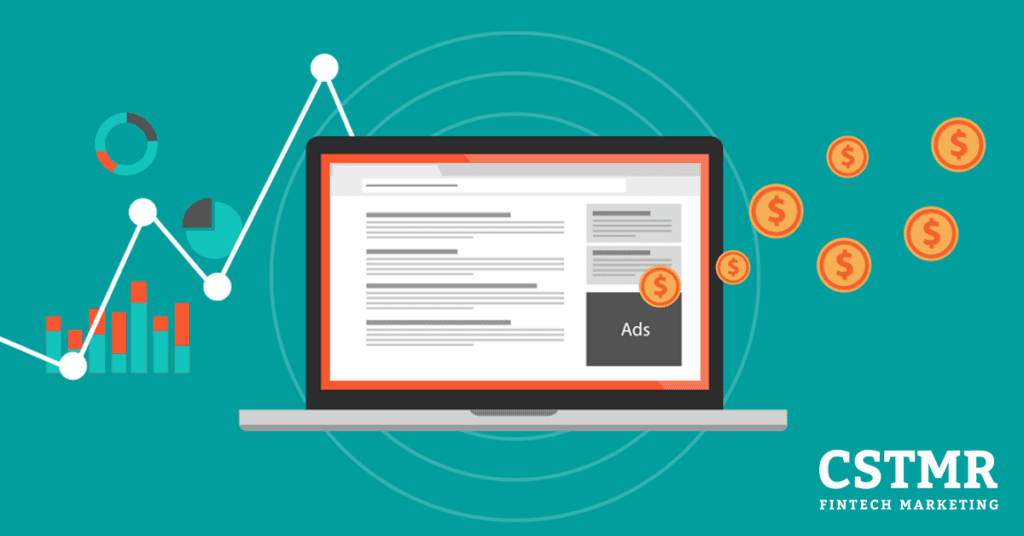Developing and operating a successful advertising strategy for your fintech or financial services business is more important than ever. To see results in today’s digital-led landscape, when consumer demand and expectations are sky-high, you need to commit to taking bold, creative steps.
Engaging your audience, converting that audience to customers, and building loyalty in those customers is a multifaceted task, and it can be tough—particularly in the finance space where you have the added complications of regulatory guidelines to adhere to.
Where Should You Focus Your Advertising Strategy?
From social media to search engines, the majority of your potential customers will be hanging out online, just waiting to be enticed.
And with 63% of people having clicked on a Google ad, your Google Ads strategy needs to be highly developed to get the best results.
It can be overwhelming to understand which metrics to focus on when you’re measuring how successful your advertising strategy is. Focus on the wrong ones and you’ll be leaving money on the table, but concentrate on the right ones, and you’ll be able to tweak and refine your ad efforts until you’re getting maximum ROI.
Here are five metrics you should be measuring to optimize your Google Adwords strategy:
Impressions and Impression Share
Quite a simple metric, but a valuable place to start, impressions are how many times your ad is displayed in search results pages as a result of your campaign.
Impression share is important to add because it shows you how many searches you actually appear in.
If your impression share is less than 10% — you only appear for 1 out of 10 searches for that keyword. We suggest an impression share of at least 70%. This is typically a budget issue, either too little spend behind it or you’re spreading budget across too many ad sets.
Focus on dominating the high-intent, high-conversion keywords that mean $$ for your business.
Click-Through Rate (CTR)
The CTR of your ad refers to how many people actually click it when they see it. It’s a metric worth watching, but, just as with impressions, you need to look past just the numbers to really understand how your campaign is working.
Some things to look for:
- Are you achieving industry-standard CTRs? On Google, this might mean a CTR of 30% on branded search, and 3-5% on generic keywords.
- If your CTR is low — this is a clear indicator that your message/offer is not resonating with your audience. The creative (or audience targeting) should probably be revamped if no other metrics are off.
For those clicks to convert, your brand needs to be relevant to the people clicking through, so the better targeted your ads are, the less unqualified people will click through. And that, even though your CTR will be lower, is a sign that your ad is doing its job in terms of targeting.
Conversion Rate
Conversions are what you’re always aiming for. And depending on your business, the definition of a conversion is fluid.
Inside Google Ads alone, we can track phone calls, form submissions, and track other conversion events by installing a snippet of code on the “thank-you” page and ensuring that the forms redirect to that page after submission.
There are also fintech apps which require a bit more work on the backend — but it’s worth it.
A business rewards credit card might choose a credit application and approval as two conversion events. In that case, you’ll have to integrate your CRM (like SalesForce) to communicate conversions back to Google Analytics, and then import these conversions into Google Ads.
A stock trading app might need to track app installs and trades inside the app — this has to be done by your developers but is KEY in scaling your campaigns.
Google conversion optimization is really good — but you’ve got to be feeding it the correct data. Ensure you have a target ROAS, a value for each conversion, and that your data matches up across platforms.
Whatever that may be, Google Ads has something that can help, conversion tracking, which lets you measure your conversion rate. A snippet of code you place on the “thank-you” page after the conversion event, this should be connected to the most valuable KPIs for your business.
However, there are a lot of other conversions that need to be set up custom — and that’s where working with an agency comes in handy. They’ve typically done this across multiple accounts in your vertical — streamlining the process.
Cost-Per-Click (CPC)
Cost-per-click is what you’re paying each time someone clicks on your ad, and it funnels into the ROI of your campaign. Are your clicks high-quality, or are you paying too much for clicks that aren’t converting well?
Cost per click is highly dependent on search volume and competition. Competitors with deep wallets can (and do) price startups out of the game.
If you find a CPC too high — dig into Google’s keyword tool to discover semantically related keywords with good search volume and lower CPCs. Long-tail keywords that remain high-intent (“best rewards business credit card for restaurants” for example) can be good money-makers.
Cost-per-Acquisition (CPA)
Cost-per-acquisition is a good metric to look at along with CPC. Not everyone who clicks through your ad will convert, be that a phone call, form submission, website visit, or something else. Once you have enough data to calculate your conversion rate, you have a formula for discovering your CPA — the cost of actually acquiring a new customer.
And while the aim is to convert, if your CPA is too high compared to the value of conversions, your profits will suffer.
At CSTMR we look at more than just numbers on a dashboard. We look deeper at what those numbers really mean, and use metrics to create thoughtful, powerful strategies and campaigns that take fintech and finance companies closer to their business goals.
To find out how we would go about crafting the most effective campaigns for your business, schedule a free advertising strategy session to start the conversation.




